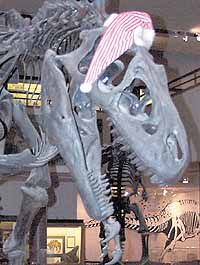| Each year “Al” the Allosaurus dons his holiday cap at the College of Eastern Utah Museum. “Al” was one of the first full dinosaur exhibits at the museum years ago and has become a kind of icon in the community. |
While each family and area has it’s own holiday traditions, universal ones tend to dominate the season. Common traditions are the Christmas tree, sending holiday cards, mistletoe hanging over the door, and various other types of goings on that few people understand or know why they exist.
The Christmas tree was a German tradition which started as early as 700 A.D. Originally the idea was from a pagan religion, but it was incorporated into the Christian holiday as the mores of the times changed.
| This unique Christmas tree is not something everyone in the community sees, but everyone should. The tree was the brainchild of the late Mike Himonas. It is made of antique barb wire and is decorated with southwestern style ornaments that Himonas collected for 15 years. Before he built the tree, the adornments used to hang on cactus’ in his home. The tree features not only different kinds of antique fencing material, but it sits on an old flag stand that he found in a barn years ago. The topper to the tree is a metal arrow produced by local artist Gary Prazen. While Mike is now gone, his wife Stacy put the tree up at his office to honor and remember him and his creativity. |
The original mistletoe tradition came from Europe where the type of plant that grows there (which is somewhat different from that found and used in the U.S.) was considered to have mystical powers. It was considered a bestower of life and fertility and an aphrodisiac. The history as it relates to todays use is long. At various times it was hung from the ceiling to ward off evil spirits or prevent the entrance of bad witches. Some cultures believed it could extinguish fire. Kissing under it was originally connected with the Greek festival of Saturnalia and later with marriage.
Christmas card sending started in the mid 1800s and quickly spread to the United States. Figures show that each year in America alone over two billion cards are exchanged.
| One of the most well known holiday traditions within Carbon County and actually throughout the state is the annual Helper Light Parade. Each year the parade travels through town for two nights culminating in a fireworks display. The tradition of a light parade for the holidays, brought the town the designation of Utah’s official Christmas town by the governor a number of years ago. It was the first official light parade for the holidays in Utah, and has since been copied in many other towns throughout the state. But as with many things, the original is still the best year in and year out. |
Candy canes have no definite history, but legend says that a choir leader in the late 1600s gave out sugar sticks to his choir members and bent them in the shape of a shepherds crook to signify the humility of the first men to worship the newborn Jesus. However it took over 200 years and a trip to the U.S. for the candy cane to take on it’s most well known form, the peppermint, red and white cane. It became a religious symbol with the body of the cane (the white part) representing the life that is pure and the red stripe symbolic of Christ’s sacrifice for mankind.
One other Christmas symbol seen is the use of Xmas in place of Christmas. While many people don’t like this, and some have even claimed it is a way for non-Christians to void Christmas’ meaning, the origin of that change came from 14th century Europe. The word for Christ in Green is Xristos, and the X was adopted from that term.
The fact is that Christmas traditions from all over the world fill numerous books, and many in one way or another, are part of anyone who celebrates Christmas tradition, including those who live in Carbon County.

